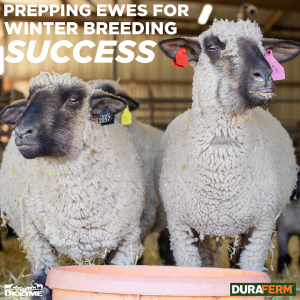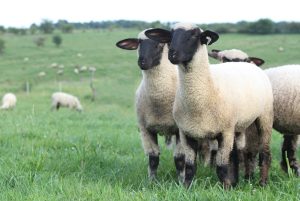
When managing your ewe flock, understanding the breeding options available can help optimize genetic gain, improve flock productivity, and adapt to market needs. Three primary methods of breeding your ewes include natural service, artificial insemination (A.I.) and embryo transfer (E.T.).
At DuraFerm®, we create nutritional supplements for sheep and goats that support optimal digestion and nutrition for maximized performance at every stage of production. Our team understands that each management scenario is different. We also know that every producer is at a different life stage and education level with regard to caring for their flock. That’s why we created this blog. We want to be sure you have a basic understanding of the various reproduction options for your ewes, the benefits and the challenges of each.
Each method—natural service, A.I. and E.T.—has advantages and limitations, and the best choice will depend on various factors. You’ve got to consider your management goals, financial resources, labor availability and desired genetic outcomes to determine which best fits your operation.
We’ve analyzed each of the three options in-depth and listed the benefits and challenges. Now, deciding how to best breed your ewes is up to you.
1. Natural Service
Natural service is the traditional and most widely used breeding method, where producers introduce rams into a ewe flock during the breeding season. The rams mate naturally with the ewes, leading to fertilization without human intervention.
Benefits
Low Cost & Simplicity
Natural service is the most economical breeding method, particularly for smaller flocks or flocks that don’t require extensive management. Natural service does not require special equipment, extensive labor or technical expertise. It does require having enough rams with genetic diversity to cover your ewes. Work with your veterinarian to ensure your rams pass a breeding soundness exam prior to turn out.
High Conception Rates
Natural service tends to result in high conception rates, as the physical and chemical signals between the ram and ewe optimize the chances of successful mating. Additionally, rams can cover multiple ewes during the breeding season. On average, a mature ram can breed up to 50 ewes if in good health and good condition.
Easier Management for Small Flocks
For smaller or less specialized flocks, the natural service method requires less day-to-day management and monitoring.
Challenges
Genetic Limitation
When using natural service, flock genetics are limited to the available rams, which may not be of the highest quality or possess the specific traits desired. This can slow genetic progress.
Ram Maintenance Costs
Rams require year-round care, housing and feeding, which can be costly. Rams can also become aggressive and may injure themselves or other animals, increasing the cost of their upkeep. Consider the time, space and feed you will need to maintain your rams year-round.
Risk of Disease Transmission
Rams and ewes in close contact increase the risk of sexually transmitted diseases (STDs) and other infections that could compromise flock health and reproductive performance.
Best Practices for Natural Service
- Ensure ewes are in optimal body condition before the breeding season to maximize conception rates.
- Maintain a ram-to-ewe ratio that meets the needs of the flock; for instance, a mature ram can typically service 30-50 ewes.
- Implement a breeding soundness evaluation (BSE) for rams to ensure they are fertile and capable of performing during the breeding season.
- Practice biosecurity measures to minimize disease transmission between rams and ewes.
2. Artificial Insemination
Artificial insemination (A.I.) involves the manual collection of semen from rams, which is then deposited into the reproductive tract of ewes by a trained technician. There are two primary methods of sheep A.I.: cervical insemination and laparoscopic insemination.
Cervical A.I.
The semen is deposited in the cervix using a speculum and insemination gun. It is less invasive but also less effective than laparoscopic A.I.
Laparoscopic A.I.
A small surgical procedure is used to deposit the semen directly into the uterine horns. This method is more effective than cervical A.I. but requires more skill and equipment.
Benefits
Enhanced Genetic Gain
A.I. enables producers to use semen from genetically superior rams from different breeding program, across the country. This can accelerate genetic improvement for traits like muscle and wool quality, growth rate and resistance to certain diseases.
Controlled Breeding
A.I. allows for better timing and synchronization of breeding, helping operations produce lambs within a specific window, which can be advantageous for marketing and management.
Reduced Disease Transmission
A.I. reduces the need for physical contact between rams and ewes, lowering the risk of disease transmission.
Challenges
Higher Costs
A.I. requires specialized skills, equipment, and in some cases, the purchase of semen from high-quality rams. Laparoscopic A.I. also requires veterinary assistance, which adds to the cost.
Lower Conception Rates in Cervical A.I.
Cervical A.I. can result in lower conception rates compared to natural service or laparoscopic A.I., particularly when using frozen semen. With cervical A.I., the semen has to pass through the cervix to reach the uterus.
Labor-Intensive
A.I. requires close monitoring of the ewes’ estrus cycles and may involve synchronization techniques such as hormone treatments, which add to labor and management demands.
Best Practices for A.I.
- Choose between cervical and laparoscopic A.I. based on the flock’s breeding goals and budget.
- Use estrus synchronization protocols to ensure that ewes are ready for insemination at the same time, increasing the efficiency of the process.
- Store and handle semen properly, especially if using frozen semen, as improper handling can reduce fertility rates.
- Ensure that technicians performing A.I. have adequate training, as this improves success rates and minimizes animal stress.
3. Embryo Transfer
Embryo transfer (E.T.) is the most advanced reproductive technology. E.T. takes fertilized embryos from a donor ewe with superior genetics and implants the embryos into recipient ewes, which act as surrogate mothers. The donor ewe is first treated with hormones to produce multiple eggs, which are typically fertilized through A.I. The embryos are then collected and transferred to recip ewes.
Benefits
Maximizes Genetic Potential
E.T. allows a single ewe with exceptional traits to produce more progeny in a year than she could naturally, amplifying the genetic gain in a flock.
International & Long-Distance Genetic Exchange
Embryos are easier to transport internationally than live animals, allowing breeders to access superior genetics from across the globe without importing live animals.
Disease Control
E.T. can reduce the risk of certain diseases by limiting the need to transport live animals and, instead, only shipping embryos, which carry a lower risk of transmitting infections.
Challenges
High Costs & Technical Requirements
E.T. is the most expensive and technically demanding method of reproduction. It requires highly skilled technicians and expensive hormonal treatments, making it suitable mainly for high-value flocks or elite breeding programs.
Management of Recip Ewes
Successful embryo transfer depends on having a healthy and synchronized group of recip ewes, which can add complexity and management costs.
Variable Success Rates
The success rate of E.T. can vary depending on the skill of the technician, the condition of the donor and recip ewes, and the quality of the embryos. Even with the best practices, some transfers may not result in pregnancy.
Best Practices for E.T.
- Select healthy donor and recip ewes, as their condition can significantly impact success rates.
- Use estrus synchronization to ensure that the recip ewes are in the same reproductive stage as the donor.
- Work with an experienced E.T. technician, as sheep embryo transfer protocol requires precise handling to avoid damaging embryos.
- Consider E.T. primarily for top-performing ewes whose genetics are valuable and worth the investment.
Comparison of the Three Breeding Methods
Each method—natural service, A.I., and E.T.—has unique advantages and limitations that make them suitable for different breeding goals.
Natural service is ideal for flock owners looking for a low-cost, low-maintenance option without specific genetic demands. It provides high conception rates but limits genetic diversity and improvement.
Artificial insemination allows for quicker genetic improvement by accessing superior genetics but requires more labor, cost and technical skills. Cervical A.I. may be suitable for large flocks aiming for incremental genetic improvement, while laparoscopic A.I. is better for flocks targeting specific genetic traits.
Embryo transfer offers the fastest genetic gain but at a prohibitive cost. It is used in elite breeding programs or for rare breeds. For most commercial operations, the cost and technical demands of E.T. may limit its use to select cases.
Nutrition is Vital to Sheep Breeding
Regardless of the breeding method you select for your flock, you will want your ewes in a good nutritional state with a good body condition score.
One of the most important aspects of getting your flock ready for breeding is to provide ewes with a complete diet. This includes a balance of vitamins, minerals, water, protein, energy and forages.
“If you do choose E.T., don’t forget the recip ewes. The recip is the host, literally taking care of the embryo, so her plane of nutrition is just as important as the donors. Make sure all ewes are on Concept•Aid® mineral to make sure they get their trace minerals,” said Sam Silvers, BioZyme Director of National Specialty Livestock. “It’s important to ensure the ewes are not overly fat or not too thin.”
With four different formulas, there is a DuraFerm mineral ideal for any sheep flock’s operational goals in mind.
DuraFerm® Sheep Concept•Aid®
Are you looking for a loose mineral that is ideal for your flock’s year-round nutrition needs? DuraFerm Sheep Concept•Aid is a free-choice vitamin and mineral supplement for sheep designed to support reproductive success.
It contains AO-Biotics® Amaferm®, a prebiotic research-proven to enhance digestibility and high levels of vitamin E for reproductive tract repair. Additionally, it supports embryo production and conception using organic trace minerals.
DuraFerm® Sheep Concept•Aid® Protein Tub
Another quality product that might even be more ideal for setting up those ewes for flushing is the DuraFerm Sheep Concept•Aid Protein Tub. This protein tub with vitamins and minerals for sheep is designed to support reproductive success.
The 125-pound tub contains the Concept•Aid sheep mineral package in a 16% natural protein tub. It supports embryo production and conception using organic trace minerals and high levels of vitamin E.
Like all DuraFerm products, it contains Amaferm to enhance digestibility.
DuraFerm® Sheep Concept•Aid® HEAT®
Keeping your ewes bred during the heat of the summer is critical. That is why we formulated DuraFerm® Sheep Concept•Aid® HEAT®, a free-choice vitamin and mineral supplement designed to support reproductive success when temperatures are above 70 degrees.
This formula contains HEAT technology, a combination of essential oils and garlic, to support animals when heat and insects are a challenge. Of course, it still contains the Concept•Aid sheep mineral package and Amaferm to enhance digestibility.
Like the other two formulas, it supports embryo production and conception using organic trace minerals and high levels of vitamin E.
DuraFerm® ONE Sheep
The newest formula in the DuraFerm Sheep line, DuraFerm ONE Sheep was developed as a free choice vitamin and mineral supplement for sheep designed to promote performance year-round.
It meets or exceeds nutrient requirements throughout the production cycle and still contains Amaferm. It is formulated with research-proven organic zinc for enhanced bioavailability.
Get your DuraFerm Today
Do you want to get ewes into optimum nutritional shape with DuraFerm Sheep products powered by AO-Biotics Amaferm? You can! DuraFerm is available through the extensive BioZyme dealer network. Locate a dealer near you today.
Don’t forget to use our Sheep Gestation Calculator. This handy guide will help you with all your sheep breeding calculations.
You can also learn more about DuraFerm from our educational blog series or by signing up for our newsletter.

